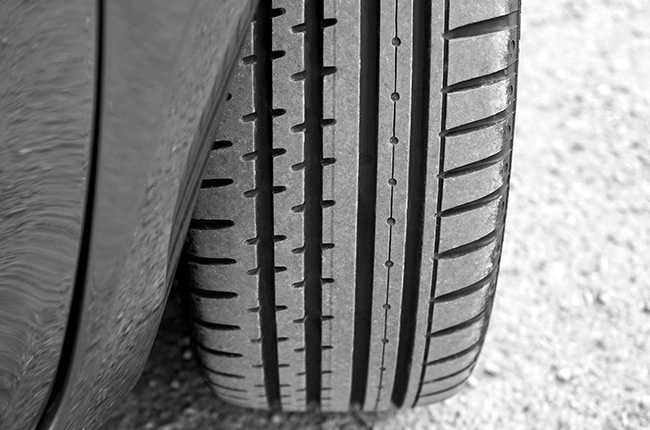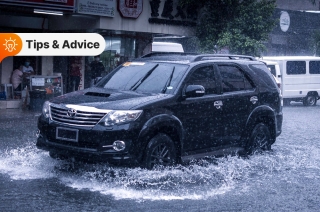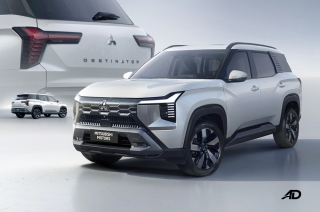
When it rains, a thin film of water will coat the surface of the road. Rain can also hamper visibility and even cause flooding. Driving in the rain is not ideal, and safety may be compromised due to these three factors.
Speed is not king in this situation, because losing control at high speeds, or hitting a pothole and damaging your tires or suspension will leave you on the side of the road with a hefty repair bill.
So, it’ll be best to go slow, but here are a few reasons why driving in the rain is dangerous and should be done with total care.
Hydroplaning and ambient temperature

Normal road tires have grooves that not only influence how much rubber comes into contact with the road but also how much water can be displaced while rolling. Water is the enemy of grip, and a layer of it on the road can cause slippage. Driving slow is a must in this scenario, as well, because a wet road increases the chances of tires locking up in emergency braking situations. Turn slowly and accelerate smoothly so you don’t overcome the limited grip of the tires in the wet.
Another factor that affects the grip of a tire is the temperature. Temperature plays a big part in how pliable and flexible the rubber compound is. If the temperature outside is cold, a tire will find it hard to grip the road since there is less flex going on.
In the rain you will battle these two elements, the water can be displaced by the grooves, but go too fast or encounter too much water, and your tires may not be able to displace fast enough, causing the slip. To top it all off the water doesn't allow the tire to find the optimal temperature to grip the road because cold tires mean less liability.
Low visibility

Water has many forms, all of which can affect visibility in some way. Starting out with the liquid form of water, too much of this on your windshield will bounce light everywhere creating a blurry image through a pane of glass. Each droplet refracts the light on your windshield and also serves as another layer that light has to pass through while it’s falling or on an obstacle.
In its gaseous form, water can stick to cold glass and hamper visibility. Rain brings humidity with it, thus making it easy for water vapor to rest on your windows especially when your air conditioning is on. You can either use your wipers or your defoggers in this scenario. You may also experience fog and may need to turn on your fog lights in order to see and be seen.

It may also hide imperfections in the road like potholes. If you hit these at speed, the least that can happen would be misaligned steering.
Apart from caring for your car, the rain also inhibits your ability to notice smaller vehicles or even pedestrians on the road. It be best to take it slow and take all your surroundings in. You should also give others time to react to your moves, so use your turn signals and not your hazards to tell people where you’re going.
Flood

In cases of extreme weather, flood can and will cause traffic, so you have no choice but to go slow through it. If you really have to traverse through floodwater, you should do so slowly, but not too slow that you are stopping and going in the water. The idea is that you have to use your momentum to keep you moving forward and push the water away. In order to clear this obstacle, you have to make sure that you keep your speed constant. Don’t slow down to a stop because this gives the water a chance to collect under the car and even your engine bay.
Needless to say, water inside an engine spells trouble. Air needs to enter into the engine through the intake hose, but water can also get in this cavity and stall the engine or even break it. You also don’t want the water level to reach the alternator, because this is an electrical component that helps your engine generate its own electricity. It may also seem that a flood is not as high, so it pays to go slow and give yourself time to discern if you can make it through without worry.
Latest Features
-
Tire tread patterns: What they are and why they matter to your car / Tips & Advice
Tire tread patterns aren’t just for looks; they also determine traction, handling, and overall performance on the road.
-
Five things to check on your car before driving during the rainy season / Featured Article
Planning to drive in the rain? Make sure to inspect these five vital parts of your car before hitting the road.
-
What we can expect from the upcoming Mitsubishi Destinator / Featured Article
The Destinator debuts this July 23, and according to Mitsubishi, it’s more than just an XForce with extra seats.
Popular Articles
-
Cheapest cars under P700,000 in the Philippines
Jerome Tresvalles · Sep 02, 2024
-
First car or next car, the Ford EcoSport is a tough package to beat
Jun 18, 2021
-
Car Maintenance checklist and guide – here’s everything you need to know
Earl Lee · Jan 12, 2021
-
Most fuel efficient family cars in the Philippines
Bryan Aaron Rivera · Nov 27, 2020
-
2021 Geely Okavango — Everything you need to know
Joey Deriquito · Nov 19, 2020
-
Family cars in the Philippines with the biggest trunks
Sep 20, 2023
-
Head to head: Toyota Rush vs. Suzuki XL7
Joey Deriquito · Oct 28, 2020
-
Why oil changes are important for your car
Earl Lee · Nov 10, 2020
-
2021 Kia Stonic — What you need to know about it
Joey Deriquito · Oct 16, 2020
-
Top 7 tips for buying a used car in the Philippines
Joey Deriquito · Nov 26, 2020




